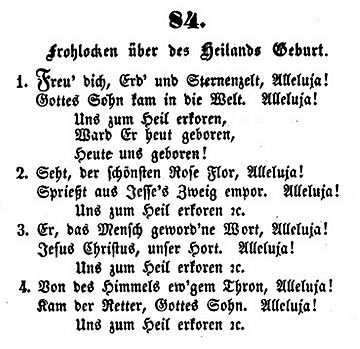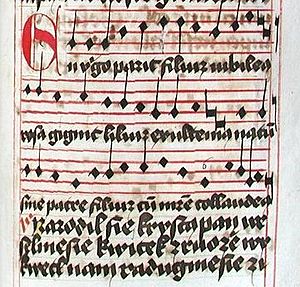Freu dich, Erd und Sternenzelt facts for kids
Quick facts for kids "Freu dich, Erd und Sternenzelt" |
|
|---|---|
| German Christmas carol | |

First print of the German lyrics, Leitmeritz 1844
|
|
| English | Be joyful, Earth and canopy of stars |
| Language | German |
| Based on | "Narodil se Kristus pán" |
| Published | 1844 |

"Freu dich, Erd und Sternenzelt" (which means "Be joyful, Earth and canopy of stars") is a famous German Christmas carol. It's a song sung during the Christmas season. The words and tune of this carol come from a very old Czech song. That Czech song is called "Narodil se Kristus pán", meaning "Lord Christ is born". This Czech carol was created around the year 1500. It was inspired by an even older Latin song, "En Virgo parit filium". The Czech song is still very popular in the Czech Republic today.
The Story Behind the Song
This German Christmas carol first appeared in a book in 1844. The book was published by the Diocese of Leitmeritz. A diocese is an area managed by a bishop in the Christian church. The book was called Katholische Gesänge für die öffentliche und häusliche Andacht. This means "Catholic Songs for Public and Home Worship". The song was titled "Frohlocken über des Heilands Geburt". This means "Rejoicing about the Saviour's birth".
The original German song had four parts, called stanzas. Each stanza had seven lines. The second and fourth lines always said "Halleluja". The last lines of each stanza were a repeating part, called a refrain. The refrain said: "Uns zum Heil erkoren, ward er heut geboren, heute uns geboren." This means "Chosen for our salvation, he was born today, today born for us."
How the Song Changed Over Time
The song was added to a Catholic hymnal in 1975. A hymnal is a book of hymns or religious songs. This hymnal was called Gotteslob.
Around 1950, a Protestant minister named Johannes Pröger changed some of the words. He replaced two of the stanzas (the third and fourth ones). His new words talked about the Annunciation to the shepherds. This is the Bible story where angels tell shepherds about Jesus's birth. This new version of the song became very popular. It is now in the Protestant hymnal Evangelisches Gesangbuch. It is also in some parts of the Gotteslob hymnal.
The Melody of the Song
The tune of "Freu dich, Erd und Sternenzelt" is simple and cheerful. It has been changed a few times over the years. In its oldest form, the music was in a triple metre. This means it had a rhythm like a waltz, with three beats in each measure. Because of its easy tune and repeating refrain, the song became a beloved folk song.
<score sound="1"> { \clef treble \key g \major \tempo 8=180 \set Staff.midiInstrument = "piano" { \set Score.tempoHideNote = ##t \override Score.BarNumber #'transparent = ##t \time 2/4 \relative c { \autoBeamOff g8 a b c | d d d4 | c8 d e4 | d4. r8 | d8 d c c | b b a4 | b8 c a4 | g4. r8 | \break b8 a b c | d4 a | b8 a b c | d4 a | g4 e' | d8 b a4 | g2 \bar"|." } } } \addlyrics { \small Freu' dich, Erd' und Ster -- nen -- zelt, Hal -- le -- lu -- ja! Got -- tes Sohn kam in die Welt, Hal -- le -- lu -- ja! Uns zum Heil er -- ko -- ren, ward er heut' ge -- bo -- ren, heu -- te uns ge -- bo -- ren! } </score>

